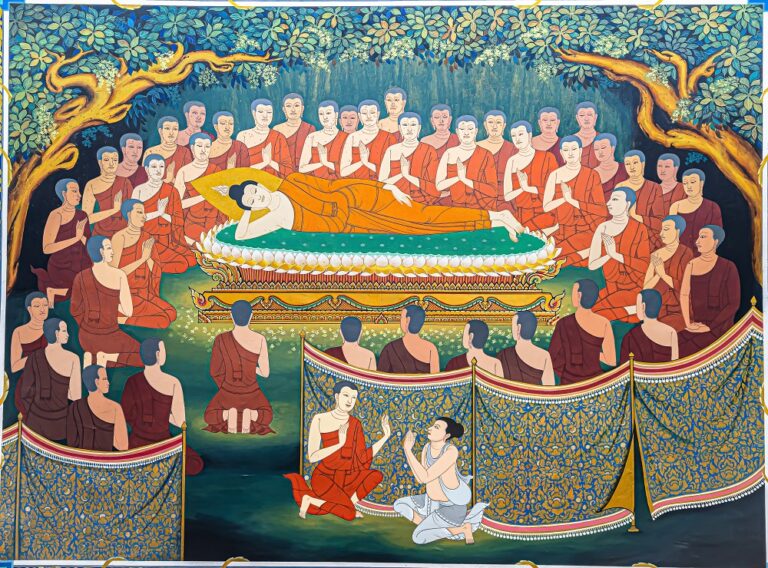
PARINIBBANNA
This mural depicts the Buddha as he is about to leave this life and attain parinibbana, or “Nirvana after death,” as opposed to the Nirvana he attained in life as the Buddha. Parinibbana implies a release from samsara, karma, and the cycle of rebirth.
At eighty years old, after a long life of teaching and practising the Dhamma, the Buddha realised that his life was coming to an end. He decided to go north to the foothills of the Himalayas, to the region where he was born.
On the journey homeward, the Buddha was offered a meal of mushrooms by Cunda, a metalworker. After the meal, he became very ill, but he suffered mindfully and with a clear understanding of his condition. He continued on his journey.
Finally, in the sala grove near Kusinara, the Buddha quietly asked his attendant, Ananda, to prepare a resting place for him between two large sala trees. (As you see In this mural) The Buddha is lying on a lotus blossom in his final resting place, between the two sala trees. He lay down on his right side, in the position of the lion, with his head to the north. The sala trees bloomed out of season, raining blossoms down around him.
The Buddha gave his final teachings, including instructions on what to do with his body after he had left. Ananda was distraught, he did not know who would teach him after the Buddha passed away. His master comforted him by reminding him that the only constant is change, that it would not be consistent with the Dhamma if he lived on. He praised Ananda, and declared that all Buddhas should have such an attendant. He said that if Ananda continued to act with such faithful loving-kindness, he would follow in the footsteps of the Buddha.
Ananda asked the Buddha to leave the world from a big, glorious city, and not from such a small village in the middle of the jungle. But the Buddha insisted that Kusināra had a splendid past, and he sent Ananda to fetch the villagers for the final night watch before his death. The villagers arrived, and Ananda presented them to the Buddha, family by family, to pay their last respects.
A wanderer named Subhadda had heard that the Buddha’s Parinibbana would take place at the end of the night, and he decided to have his doubts about the Dhamma resolved by speaking with the Buddha. He approached the sala grove, and told Ananda his request, but Ananda refused him. He asked two times, three times, and Ananda refused him two times, three times. The Buddha overheard this, and asked Ananda to allow Subhadda in. Then, he proceeded to teach the Dhamma one last time, making Subhadda his last direct disciple.
The Buddha reminded his heartbroken followers that they would not be without a master when he died, but that the Dhamma would now be their master. Then, the Buddha said his final words: “Everything is impermanent. Practice with mindfulness.”
In 543 BC, the Buddha entered into the final Nirvana.
The villagers wept, the monks wept, and the devas wept, but those who had already attained freedom from passion were mindful that all things change, and it could be no other way.